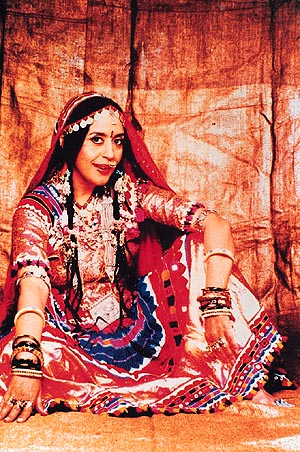Illa's enduring charm
By Janaki Bhatt
T
EN years ago, she was known as the choli girl. Music composers Laxmikant-Pyarelal had got this little known folk singer from Rajasthan to record for a Subhash Ghai film, Khalnayak. The controversial number, choli ke peechey kya hai made Ila Arun an instant hit.Thereafter, she came out with about a dozen chart-busters such as Bicchuda, Nigodi and Banjaran. She also made occasional appearances on the screen and sang for some potboilers like Lamhe, Dalal, Mohabbat ki Arzoo and Batwara. And then there was lull.
Ila Arun now stages a comeback with her new album Haule Haule — a path-breaking effort in Indian folk music that draws upon the genius of south Indian music composer, Karthik Raja. The latter is the son of the legendary Illayaraja.
| Bombay happened when her cousin, Lalit Sen migrated to join uncle Jatin Sen as a music composing duo for Hindi films. By then, Ila's brothers Piyush and Prasun Pandey had also moved to the city to chase their dreams in advertising. "Initially I could feel the resistance to my songs because I did not sound like Lata Mangeshkar or Asha Bhosle," narrates Ila. "Right then, I had decided not to be a copycat like the other female singers of the time. I figured out that if I had to make a name for myself, it would be on the strength of my own voice." It was a hard decision to take because the coarse, rustic voice was scarcely suited to playback. She herself admits that no heroine would have wanted to be heard in a hoarse voice. So when the choli number from Khalnayak became a hit, she was most surprised. "The thing about us Indians is that we haven't got over our herd mentality," she explains. "I was amazed at the number of sound-alikes who came up after me and all of them were getting opportunities for playback singing. Anyway, by then, I had already started recording for non-film albums." Ila attributes her success to the way she has been able to integrate modern techno music with folk melody. "People accuse me of compromising the essence of folk tunes," she clarifies. "I say nothing in the songs has been tampered with. It is only the packaging that is different." She picks up a song, lalua lalua sab koi pukare from her latest album. A patriotic number addressed to Indians settled abroad to return to their homeland, it is composed of calypso beats and alaaps to create a feel of the traditional and modern. "Such numbers are very popular abroad," she points out. "So in every album, I make it a point to carry a message for the Indian immigrants, saying that their country needs them back. But would you believe it, my biggest fans are not foreigners or NRIs, but the humble nomads of the Rajasthan desert!" — Maharaja Features |



 "My last four albums were composed by Lalit Sen," informs the singer. "This is the first time I have worked with a south Indian composer who is amazingly in total grips with the nuances of north Indian folk traditions. For me, the experience was like a pilgrimage-cum-voyage of discovery!"
"My last four albums were composed by Lalit Sen," informs the singer. "This is the first time I have worked with a south Indian composer who is amazingly in total grips with the nuances of north Indian folk traditions. For me, the experience was like a pilgrimage-cum-voyage of discovery!"















